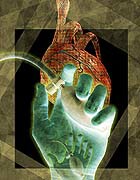- Cancer Takes Tough Toll on Family Finances
- You Might Fare Better If Your Doctor Is Female, Study Finds
- CDC Launches Online ‘Heat Forecaster’ Tool as Another Summer Looms
- Biden Administration Sets Nursing Home Staffing Minimums
- Neosporin Ointment in the Nose Might Be Potent Antibiotic
- Physical Ills Often Plague People With Schizophrenia, Bipolar
- Taking Psilocybin for Depression? Relationship With Therapist Is Key
- Stick to Heimlich Maneuver Not ‘Anti-Choking’ Devices, FDA Says
- Women in the Military at Risk for Low-Weight Babies
- Repeat Blasts Can Damage Soldiers’ Brains, Study Confirms
Donor Hearts Going to Waste, Researchers Report


Even as the need for heart transplants increases, more donor hearts are being discarded, with a new study showing that only one in three donated hearts finds a recipient.
In addition, rejection of donor hearts varies across the United States, particularly for so-called “marginal” donor hearts — those that are judged too small or too old. Hearts that would be used in one medical center would be rejected by another, said lead researcher Dr. Kiran Khush, an assistant professor of cardiovascular medicine at Stanford University School of Medicine, in Palo Alto, Calif.
“We have a lot of patients awaiting heart transplantation and the waiting lists are growing and the waiting times are increasing, but despite this, we are not using a lot of available hearts,” she said.
Each year in the United States, more than 20,000 people are waiting for heart transplants, but only slightly more than 1,900 patients received a new heart in 2011, the researchers reported.
Part of the problem is a lack of good data on which hearts should be used and which should not, Khush said.
In addition, the number of donor hearts deemed acceptable for use has decreased significantly over time. Acceptance of donor hearts declined from 44 percent in 1995 to 29 percent in 2006, but rebounded slightly to 32 percent in 2010, the investigators found.
“We are basically using one out of three available hearts,” Khush said. “That is concerning, because there are a lot of hearts that are not being used despite the huge donor shortage.”
Khush explained that the process of defining which hearts can be used is not uniform. “Our acceptance procedures need to be more standardized, and we need to work together to improve utilization of hearts and make heart transplantation more available to more patients,” she said.
The new report was published online Feb. 10 in the American Journal of Transplantation.
Using data from the U.S. government’s Organ Procurement and Transplantation Network for 1995-2010, the research team found that of roughly 82,000 potential donor hearts, 34 percent were accepted and 48 percent were rejected. An additional 18 percent were used for other purposes, such as research.
Among the reasons for discarding donor hearts were small size, advanced age and medical problems of donors, such as high blood pressure and diabetes.
“However, when we look closely at the data, we find that most of these hearts do perfectly well in their recipients,” Khush said. “As a transplant community, we have become very conservative in terms of which donor hearts we use because we are worried about bad outcomes.”
Another factor that might explain why donor heart acceptance rates have dropped is the increased use of mechanical heart pumps that can keep patients alive until a suitable heart is found, she added.
Also, government agencies have increased their oversight of the 140 or so transplant centers across the country, Khush said. As a result, surgeons may be more cautious about the hearts they use, thus upping the rejection rate of marginal hearts, she said.
The American Society of Transplantation (AST) offered its own reasons as to why there’s been a decline in the acceptance of donor hearts.
“One of the major reasons is the decrease in donor heart quality,” the AST said in a statement. It pointed out that the average age of donors rose from about 40 to 43 years between 1995 and 2010. And 40 percent of donated hearts now come from people aged 50 or older.
At the same time, there’s been a steep rise in conditions that can affect the quality of a donated heart, such as diabetes and high blood pressure, the group said.
The study authors said that more donor hearts were accepted in the Northeast, where there are more transplant centers. In areas such as the Pacific Northwest, where there are fewer transplant centers, more marginal hearts were rejected, the study authors found.
“Heart transplantation remains the most effective treatment for patients with advanced heart failure,” said Dr. Gregg Fonarow, a professor of cardiology at the University of California, Los Angeles.
“Unfortunately, there is a severe shortage of donor hearts and it remains critical to maximize potential donor heart utilization,” said Fonarow, who is also a spokesman for the American Heart Association. “This study suggests there may be an important opportunity to improve donor heart evaluation and acceptance with development and uniform use of guidelines based on good medical evidence.”
More information
Visit the U.S. National Library of Medicine for more on heart transplants.
Source: HealthDay
Copyright © 2024 HealthDay. All rights reserved.










